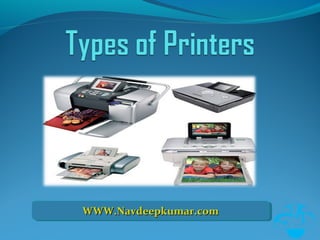
Types of Printers
- 2. Introduction An output device is any piece of computer hardware equipment used to communicate the results of data processing carried out by an information processing system(such as a computer) to the outside world. WWW.Navdeepkumar.comWWW.Navdeepkumar.comWWW.Navdeepkumar.comWWW.Navdeepkumar.com
- 3. What are Printers.....? Printer are the most commonly used output devices that provides the user with a permanent visual record of the output data in human readable form known as hard copy. They can print on plain paper or on specially prepared forms such as invoices, labels, bills, checks and other special purpose forms used in business. Their are several types of printers designed for wide range of application. WWW.Navdeepkumar.comWWW.Navdeepkumar.comWWW.Navdeepkumar.comWWW.Navdeepkumar.com
- 4. Impact Printers Impact printer produces text and images when tiny wire pins on print head strike the ink ribbon by physically contacting the paper. Non Impact Printers Non-impact printer produces text and graphics on paper without actually striking the paper. WWW.Navdeepkumar.comWWW.Navdeepkumar.comWWW.Navdeepkumar.comWWW.Navdeepkumar.com
- 5. Impact vs. Non-impact Impact - These printers have a mechanism that touches the paper in order to create an image. There are two main impact technologies: Dot matrix printers use a series of small pins to strike a ribbon coated with ink, Character They have a series of bars with actual characters (letters and numbers) embossed on the surface . Non-impact - These printers do not touch the paper when creating an image. Inkjet printers, which are described in this article, use a series of nozzles to spray drops of ink directly on the paper. Laser printers, covered in-depth in How Laser Printers Work, use dry ink (toner), static electricity, and heat to place. WWW.Navdeepkumar.comWWW.Navdeepkumar.comWWW.Navdeepkumar.comWWW.Navdeepkumar.com
- 6. Types of Impact Impact Printer’sImpact Printer’s Dot-matrix printer Drum printer Chain printer Daisy Wheel WWW.Navdeepkumar.comWWW.Navdeepkumar.comWWW.Navdeepkumar.comWWW.Navdeepkumar.com
- 7. Dot-Matrix Dot MatrixDot Matrix refers to the way the printer creates characters or images on paper. This is done by several tiny pins, aligned in a column, striking an ink ribbon positioned between the pins and the paper, creating dots on the paper. Characters are composed of patterns of these dots by moving the printhead laterally across the page in very small increments. WWW.Navdeepkumar.comWWW.Navdeepkumar.comWWW.Navdeepkumar.comWWW.Navdeepkumar.com
- 8. Advantages Versatile Print letters in italics or bold Relatively inexpensive Used to print carbon copies WWW.Navdeepkumar.comWWW.Navdeepkumar.comWWW.Navdeepkumar.comWWW.Navdeepkumar.com
- 9. Drum Printer An old line printer technology that used formed character images around a cylindrical drum as its printing mechanism. When the desired character for the selected position rotated around to the hammer line, the hammer hit the paper from behind and pushed it into the ribbon and onto the character. WWW.Navdeepkumar.comWWW.Navdeepkumar.comWWW.Navdeepkumar.comWWW.Navdeepkumar.com
- 10. Chain Printers An early line printer that used type slugs linked together in a chain as its printing mechanism. The chain spins horizontally around a set of hammers. When the desired character is in front of the selected print column, the corresponding hammer hits the paper into the ribbon and onto the character in the chain. Chain and train printers gave way to band printers in the early 1980s. WWW.Navdeepkumar.comWWW.Navdeepkumar.comWWW.Navdeepkumar.comWWW.Navdeepkumar.com
- 11. Daisy Wheel Printers Daisy wheel printers use an impact printing technology invented in 1969 by David S. Lee at Diablo Data Systems. It uses interchangeable pre-formed type elements, each with 96 glyphs, to generate high- quality output comparable to premium typewriters such as the IBM "Golfball" Selectric, but three times faster. Daisyand-wheel printing was used in electronic typewriters, word processors and computer systems from 1972. WWW.Navdeepkumar.comWWW.Navdeepkumar.comWWW.Navdeepkumar.comWWW.Navdeepkumar.com
- 12. Electrostatic Printers printers use a special photographic paper that allows characters to be etched onto the paper using a stylus. The stylus, made up of tiny wires, forms characters by placing an electrostatic charged image on the paper. Then, as the paper is moved through a toner solution containing ink particles, the ink adheres to the charges that form a pattern on the paper to develop the character. This type of printer can be used for both printing and plotting (displaying graphic output), and can print up to 5,000 lines per minute WWW.Navdeepkumar.comWWW.Navdeepkumar.comWWW.Navdeepkumar.comWWW.Navdeepkumar.com
- 13. Types of Non Impact Printers Non Impact Printer’s Inkjet printers Laser printers WWW.Navdeepkumar.comWWW.Navdeepkumar.comWWW.Navdeepkumar.comWWW.Navdeepkumar.com
- 14. Inkjet Printer Inkjet printers are non-impact printers which print text and images by spraying tiny droplets of liquid ink onto paper. They are the most popular printers for home use. The inkjet head design is also divided into two main groups: fixed- head and disposable head. Fixed-head is built into the printer and should last for the whole life of the printer. It produces more accurate output than cheap disposable head. The ink cartridges for fixed head printers are also cheaper as the print head does not need to be replaced. However, if the head is damaged, the entire printer has to be replaced. WWW.Navdeepkumar.comWWW.Navdeepkumar.comWWW.Navdeepkumar.comWWW.Navdeepkumar.com
- 15. Inside an Inkjet Printer. Print head. Ink Cartridges. Stepper motor Belt. Rollers. Control Circuit. WWW.Navdeepkumar.comWWW.Navdeepkumar.comWWW.Navdeepkumar.comWWW.Navdeepkumar.com
- 16. Laser Printer Laser printers are non-impact printers which can print text and images in high speed and high quality resolution, ranging from 600 to 1200 dpi. Unlike inkjet printers, laser printer use toner (black or colored powder) instead of liquid inks WWW.Navdeepkumar.comWWW.Navdeepkumar.comWWW.Navdeepkumar.comWWW.Navdeepkumar.com
- 17. THANKS FOR GIVING YOUR VALUABLETHANKS FOR GIVING YOUR VALUABLE TIME…………………TIME………………… Contact at: email@Navdeepkumar.comContact at: email@Navdeepkumar.comContact at: email@Navdeepkumar.comContact at: email@Navdeepkumar.com
